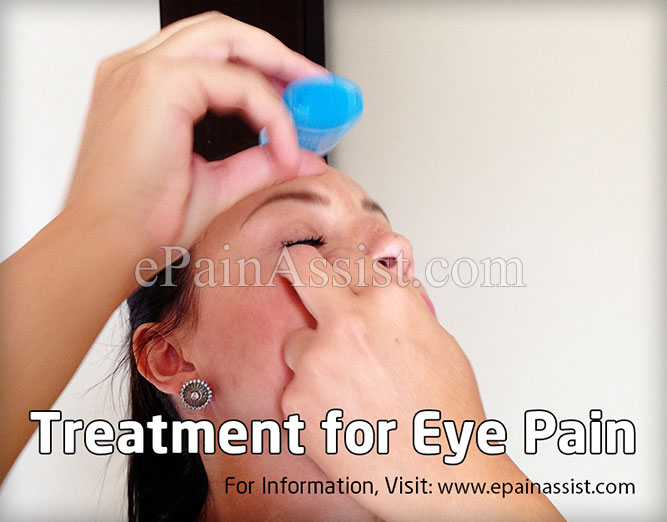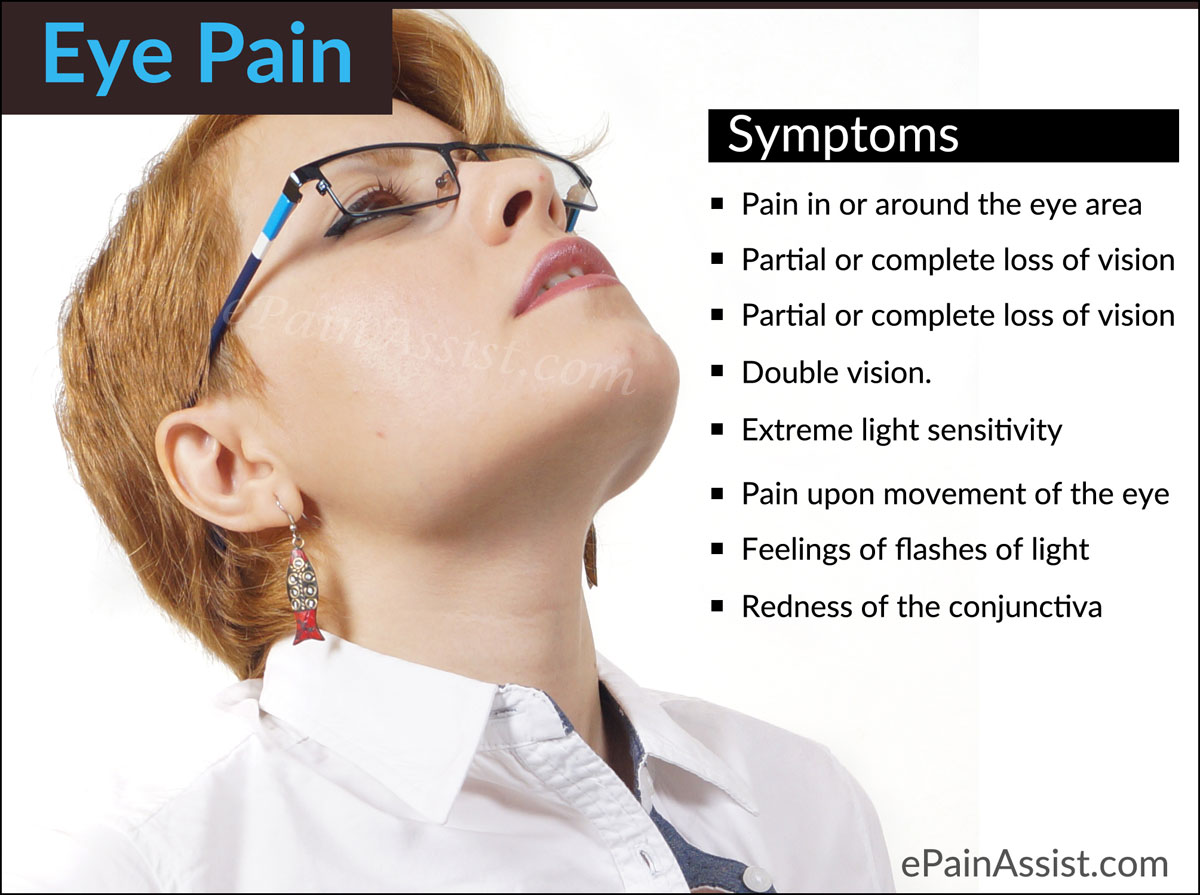What is Eye Pain?
Eye pain can be a very irritating condition to have, as it can greatly affect an individual’s day-to-day normal activities. Eye pain or irritation can be of various types. It can be felt as a sharp, shooting, burning, dull, gritty, stabbing sensation or a feeling of a foreign body in the eye, aching, pressure like sensation, throbbing type of pain etc. Whatever the nature of eye pain or irritation, it makes the patients feel very uncomfortable and it needs to be looked into immediately. In some cases, the eye pain can be confused with other symptoms like headache, sinus pain, toothache or a migraine. Eye pain can occur in any part of the eye, such as it can occur on the surface of the eye or deep, inside the eye from its inner structures. Eye pain occurring on the surface of the eye is usually felt as itching, burning, or shooting pain. It is mostly due to presence of a foreign object in the eye or an eye infection or basically anything, which can cause irritation or inflammation of the eye membrane. On the other hand, eye pain originating from deep within the eye is usually felt as throbbing or aching type of pain. This may be due to a serious medical condition. If the eye pain is very acute or intense and is accompanied by any amount of vision loss, it is an indication of a serious medical condition and requires attention urgently.
Classification and Types of Eye Pain
The type of eye pain depends on the cause, but there are two primary types of pain based on its location.
- Ocular Eye Pain: This type of eye pain occurs on the external side of the eye, like pain on the surface of the eye and the surrounding structures of the eye such as the inner eye lids. It usually consists of burning, irritation, shooting pain, and can be accompanied by itching.
- Orbital Pain: This type of pain feels as though it is coming from deep inside the eye or from behind the eye. It is located in the internal portion of the eye and is felt as a throbbing or a dull ache.
Causes and Risk Factors of Eye Pain
- Allergies
- Blepharitis
- Blocked tear duct
- Sty
- Chalazion
- Cluster headache
- Problem due to contact lens
- Abrasion of the cornea
- Corneal ulcerations
- Dryness of the eyes
- Ectropion
- Entropion Foreign object in the eye
- Glaucoma
- Inflammation of the sclera (scleritis)
- Injury/trauma
- Iritis (inflammation of the colored part of the eye)
- Optic neuritis
- Conjunctivitis (Pink eye)
- Sinusitis
- Migraines
- Blocked oil gland
- Uveitis
- Chemical/flash burns.
Symptoms of eye pain depend of the cause of eye pain. Eye pain is often accompanied by other symptoms such as:
- Pain in or around the eye area.
- Partial or complete loss of vision.
- Extreme light sensitivity.
- Double vision.
- Halos which are colored circles or halos around lights.
- Floaters such as spots, strings, or shadows before the eyes.
- Restriction in normal eye movement.
- Pain upon movement of the eye.
- Feelings of flashes of light.
- Intense headache with eye pain.
- Redness of the conjunctiva.
- Redness that is flaring out and surrounding the iris.
- Irregular pupil shape.
- Protrusion or bulging of the eye.
- Swelling or redness of the surrounding eye structures such as eyelids.
- Blood or pus in the front of the eye.
- Eye discharge.
- Excessive tearing in the eye.
- Crusting of the eyes or sticking of eyelids together (especially upon awakening).
- A scratch to the cornea or eyeball.
Symptoms Indicating Serious Condition Are:
- Eye pain accompanied with loss of vision.
- Loss of eye movement.
- Very painful eye movement.
- Swelling in the eye with discharge.
- Severe headache.
- Sudden changes in the vision.
- Eye is very painful to the touch.
- Abdominal pain or vomiting with eye pain.
- Eye pain caused due to a foreign object or chemical.
Eye Examination to Diagnose Eye Pain
- History and physical examination.
- Pain questionnaire.
- Eye examination such as checking of vision, visual inspection of the eye and its surrounding tissue, and examining eye movements, the visual fields (peripheral vision), and the pupil’s reaction to light.
- Slit-lamp examination.
- Fluorescein examination.
- Eye pressure check for glaucoma.
- An ophthalmoscope is used for examining the back of the eye and to visualize the optic disc and blood vessels.
- Tonometer is sued for checking eye pressure.
- A special black light with fluorescein dye is used to detect any eye abrasions, ulcerations or any corneal defect.

Treatment for Eye Pain
- The eye should be flushed with water in case of a foreign body or exposure to chemical to the eye.
- If foreign body is the cause of eye pain, rubbing the eye should be avoided as it causes serious damage to the eye as the foreign body is moved around with rubbing. Patients should not try to remove the foreign body by themselves and should visit an ophthalmologist immediately. Foreign body can be removed with irrigation with eye wash, a cotton tip applicator, a small needle, or with an ophthalmologic drill, but it should be done by a medical professional. An abrasion or a rust ring results after the foreign body removal and it should be treated.
- In case of mild eye discomfort, resting the eyes may be enough.
- Pain medications sold over the counter like ibuprofen or acetaminophen can be taken.
- Avoiding very bright light.
- Warm compresses can be used on sty or a chalazion. An antibiotic ointment can be also be used. If there is no improvement then the ophthalmologist may open it up to drain the infection.
- In case of bacterial conjunctivitis, antibiotic eyedrops, eye ointment, and pain medication is given. For viral conjunctivitis (pink eye), treatment is the same as bacterial conjunctivitis, as sometimes it can be difficult to tell the difference between bacterial and viral infection. Allergic conjunctivitis is treated with antihistamines like Benadryl.
- Corneal abrasions and ulcerations are treated with antibiotic eyedrops, eye ointments and pain medications.
- Chemical eye burns and corneal flash burns should be treated immediately with large amount of water to flush out the eye and anesthetic eye drops. Flash burns are treated with antibiotic eyedrops, eye ointments, and pain medications.
- In case of blepharitis, patient is instructed to scrub the edges of eyelid with a mild shampoo using a soft washcloth twice a day.
- Severe glaucoma can be a true eye emergency with permanent eye damage occurring within several hours. Treatment is with eye drops containing a topical beta-blocker, a topical steroid drop, and a pupillary constricting eye drops. Other medicines can be given intravenously or in tablet form. If these treatments fail then surgery may be required.
- Iritis is treated with eyedrops that cause the pupils to dilate and with topical steroid eyedrops. For severe iritis, oral steroids can be used.
- Optic neuritis causes symptoms such as gradual vision loss and painful eye movement. A thorough work-up needs to be done by an ophthalmologist as well as a neurologist to determine the cause of optic neuritis.
- Antibiotics are generally used to treat sinusitis.
- Migraines causing eye pain can be treated with over-the-counter medications, like ibuprofen (Motrin) and acetaminophen (Tylenol). Prescription migraine medications can be also used.
- Trauma to the eye such as penetrating injuries to the globe of the eye should be looked at by an ophthalmologist and should be treated immediately.
- Patients should return to their ophthalmologist or the emergency room if they have any recurrent symptoms in their eyes.
Preventative Steps for Eye Pain:
- Wearing protective gear such as goggles while working with hand tools, power tools, and industrial chemicals.
- Wearing safety goggles and a safety helmet when playing sports, such as basketball, racquetball, tennis and baseball, and a face mask while playing hockey.
- Always point the nozzle away from the eyes when working with potent chemicals like cleaning fluids, ammonia, detergents, and spray chemicals.
- Parental guidance is required when children are playing with spring-loaded toys that shoot darts and other objects, plastic swords, BB guns and fireworks.
- Activities like gardening and lawn mowing should be carefully done and any rocks and sticks should be removed before mowing and low-hanging branches and trees should be avoided.
- Proper routine eye care should be used when wearing contact lenses in order to prevent contact lens-related eye injuries and patients should be careful while removing, applying, and washing their contact lenses.
Relevant Source Links:
- Eye Pain (Ophthalmalgia) Overview – Healthline
- Common Eye Problems and Injuries – American Academy of Ophthalmology
- Eye Pain: Causes, Symptoms, and Treatment – WebMD
- Eye Pain and When to Seek Help – Mayo Clinic
- Eye Injury Prevention – National Eye Institute
Also Read:


